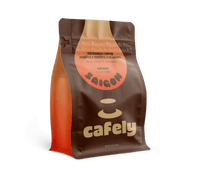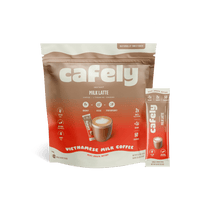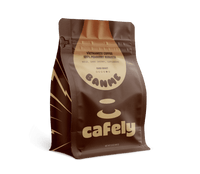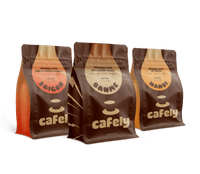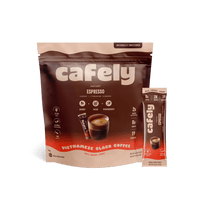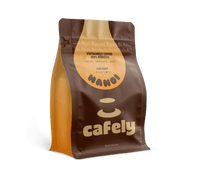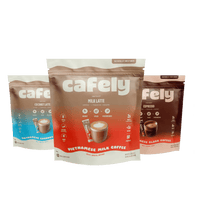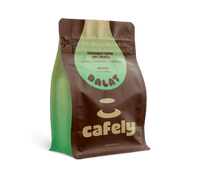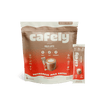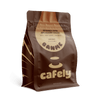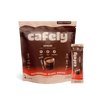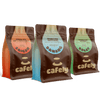Since so much coffee is grown around the world in different environments, there’s a wealth of unique and delicious brews out there. One of these is the famous Vietnamese coffee, which is made using robusta coffee that’s brewed with a Phin filter. The brew is often hit with a dash of condensed milk — producing a rounded, balanced sweetness.
Read on to learn what the best coffee for Vietnamese brews is, as well as the history of coffee in the country, and how to make the perfect cup.
What’s the Best Coffee for Vietnamese Coffee?
Vietnamese coffee is traditionally made with beans from the Coffea robusta plant. Robusta coffee is strong, dark, and bold. It’s around twice as potent as arabica coffee and produces a rich, bitter brew. This bitterness is often balanced out with sweetened condensed milk.
Here’s what to look for and consider when selecting the best coffee for traditional Vietnamese coffee:
- Robusta Coffee — Robusta coffee is the traditional coffee used to make Vietnamese coffee. If you want to make an authentic Vietnamese brew, opt for 100% robusta rather than arabica beans or a blend. Peaberry robusta also works remarkably well in Vietnamese coffee.
- Arabica & Robusta Blends — Although not strictly traditional, you’ll often find arabica and robusta blends in Vietnam. If you prefer a slightly smoother coffee with less bitterness, opt for a blend.
- The Phin Filter — If you want to make authentic Vietnamese coffee you’ll need a traditional Vietnamese phin filter. This simple piece of brewing equipment works similarly to a pour-over coffee maker, with the addition of a gravity press.
- Condensed Milk — Most people in Vietnam use condensed milk to sweeten and cream the coffee. The sweet, smooth creaminess of condensed milk mellows out the harsh, dark flavors of robusta.
How to Choose the Best Coffee Beans for Vietnamese Coffee

Let’s break down some elements that make coffee suitable for making traditional Vietnamese coffee:
1. Robusta
Robusta beans are much more prevalent throughout Vietnam than high-quality arabica beans are. They grow an awful lot better, and there’s a lot of history that has led to the current love of them — making Vietnam home to some of the best robusta coffee brands in the world. Therefore, whenever Vietnamese coffee is brewed on a street corner with locally grown and roasted beans, a Vietnamese barista will choose locally grown robusta over arabica.
One of the core notes that people adore in Vietnamese coffee is the combination of intensely bitter robusta coffee and sweet, creamy condensed milk. These conflicting qualities produce a perfectly balanced cup of coffee.
2. Dark Roast
Vietnamese beans have traditionally been roasted darkly to mask the flavors of poor crops, but the tradition has continued since farming and drying processes have improved. This traditional practice of dark roasting has continued due to the amazing flavors it produces.
Typically, dark roast beans have notes of chocolate and caramel — perfectly complimenting the sweetness and creaminess of condensed milk in Vietnamese coffee.
3. Organic Growing Practices
Another thing you should consider when buying Vietnamese coffee is the growing practices. If you choose beans that are grown through organic practices, you ensure that everything in your cup is as clean and delicious as possible.
While pesticides and herbicides aren’t necessarily bad if they’ve been proven safe, buying organic coffee beans means the farmers avoid using these potentially harmful chemicals in their products. On top of this, organic farming leads to stronger plants and, in turn, a richer, more complex fruit.
4. Mold-Free
Many coffees produced internationally can contain a number of contaminants. Some of these contaminants include mold, or the byproducts of mold having been on or around the coffee beans themselves.
You’ll want to buy from brands that are certified mold-free so you don’t have to worry about mycotoxins or other harmful ingredients.
5. Coffee from the Central Highlands
The central highlands are the main coffee-growing region in Vietnam, an amazing place to source your coffee because of the rich tradition of coffee-growing knowledge. This knowledge, passed from farmer to farmer, has led to some of the best dark roast arabica beans in the world coming from the region.
Furthermore, the altitude in the region means the plants are grown at a lower temperature, which allows the beans to ripen more slowly — producing the most profound flavors.
6. Butter-Roasted
Butter roasting beans is a traditional Vietnamese practice, and it’s backed up by modern science to create fascinating and complex flavors throughout many different brews.
During roasting, coffee undergoes something called the Maillard reaction, where heated chemicals bond and change to create new flavors. This also happens to butter, so when butter and beans are mixed before brewing, the twin reactions lead to the final flavor being transformed into something utterly wonderful.
7. Strong Flavor and Caffeine Content
Vietnamese people are proud of their tradition of exceptionally strong coffee, and the brews sold on street corners are often as potent as they are sweet. Robusta beans are traditionally used throughout the country, and these beans produce twice as much caffeine as arabica beans.
What Makes Vietnamese Coffee Unique?

Let’s explore the world of Vietnamese coffee together and talk about what makes it different from other contemporary coffee cultures.
1. How Coffee Made It to Vietnam
Between 1883 and 1954, Vietnam was a French colony, giving the French access to this land with a completely different geography and climate from their home. Seeing the volcanic soil throughout the country, the settlers experimented by planting different crops in the region, hoping to find something that would grow well.
They planted different types of coffee, but ongoing struggles with labor shortages and plant diseases meant that only a few crops truly seemed to thrive.
2. Robusta’s Role in Vietnamese Coffee
One main coffee type thrived in this environment — Coffea robusta (robusta coffee). This species of coffee is significantly more resilient and resistant to insects due to its higher caffeine content, making the crop popular among farmers. Meanwhile, robusta’s high caffeine content converted many Vietnamese people to coffee drinkers, and a tradition of strong coffee quickly took root throughout Vietnam.
3. Vietnam’s Unique Growing Regions
The Vietnamese government recognized that coffee could be a great way to boost the economy, so they encouraged coffee production in the highlands of the country with various economic incentives.
The geography of these highland growing regions is brilliant for coffee plants for three main reasons — the soil itself is volcanic, the altitude is consistently high among farms, and the climate has distinct wet and dry seasons.
The volcanic soil is packed with minerals that the coffee plants can absorb to grow well, and the distinct wet and dry seasons aid the growing process, too. This means that robusta plants can produce larger yields in a predictable time period. The elevation of the farms impacts the flavor of the beans — high altitude means cooler temperature, which can lead to the beans maturing more slowly and thus developing a more rounded flavor.
4. Phin Filter Coffee Brewers
The phin filter is a simple piece of coffee brewing equipment that was created in Vietnam and has stuck around for its aforementioned simplicity. It’s a very basic tool made up of four pieces — the filter, the brewing chamber, the gravity press, and the lid.
The filter is fitted to the base of the brewing chamber, and the whole assembly is then placed onto a cup. Then, coffee is added along with hot water, and the gravity press is placed on top of the brewing coffee. Finally, the lid is placed on top, and the brew slowly drips through the filter into the cup.
This results in a rich, dark flavor with a smooth, thick mouthfeel. It’s a dependable, low-tech brewer that’s cheap to manufacture and cheap to buy. These factors worked together, making the brewer popular in Vietnam.
5. Condensed Milk and Butter
One particular way in which Vietnamese coffee is different from other brews around the world is through the use of different additives to make a more interesting cup. Namely, these are condensed milk and butter.
Condensed Milk in Vietnamese Coffee
Condensed milk has long been used in Vietnamese coffee as something to add to your drink, as you might with milk or sugar. The flavor of sweetened condensed milk compliments robusta coffee well. The sweet, butterscotch-like flavor balances out the strong, bold flavors of robusta.
Another reason condensed milk is popular in Vietnam is that it doesn’t require refrigeration. This is especially important in a hot, humid country like Vietnam, where unrefrigerated milk spoils instantly.
Butter Roasting Robusta Beans
Another interesting addition to Vietnamese coffee is butter. Some traditional roasters use butter to roast the coffee beans, giving the coffee a smooth, creamy finish.
Historically, butter roasting was done to mask the flavors of a low-quality crop. Thankfully, the advancements in modern farming techniques mean that this no longer needs to be done. Instead, coffee plants are grown and harvested to higher standards and produce tastier beans.
However, the butter roasting tradition lives on, not to mask the flavor of a low-quality bean but to enhance the flavors of a high-quality bean.
How to Brew the Perfect Cup of Vietnamese Coffee
Wondering how to make a perfect cup of Vietnamese coffee? You can’t go wrong with a dark roast robusta, a phin filter brewer, and a healthy helping of condensed milk.
Here’s a quick rundown on how to make Vietnamese coffee:
- Start by adding condensed milk to the base of a mug (or, more traditionally, a heat-proof glass). One to three tablespoons is typical, so you might find you need to adjust things a little to achieve the perfect balance for you.
- Place the filter into the base of your phin brewer, and then place the brewer on top of your mug. Add the coffee and brew it with hot water.
- After you’ve waited for your phin brew to slowly finish dripping, you may have to stir to ensure the condensed milk is totally dissolved.
- Finally, add ice if you’d like, and enjoy!
Why Buying Authentic Vietnamese Beans Matters

If you want to make the most authentic Vietnamese coffee, buying authentic robusta beans from Vietnam is essential. However, making a good cup of coffee isn’t the only reason to buy genuine Vietnamese coffee…
Knowledge and Tradition
When buying top-quality Vietnamese coffee, you’re not only paying for the beans and the time taken to process them, but you’re also paying for the tradition those beans represent. Vietnam has a coffee culture unlike anywhere else in the world, so by buying directly from a Vietnamese company, you’re buying a slice of that culture.
The culture is packed with knowledge and tradition, from the field to the roastery. The farmers have grown coffee there for generations, and traditional methods ensure that each crop is spectacular in a brand-new way.
The roasters have been roasting for a similarly long time, and their knowledge of the traditional coffee they’ve grown up with informs the decisions they make. Together, this tapestry of culture creates coffee unlike any other.
Economy
Vietnamese farmers in the highlands were actually encouraged by the government to grow coffee beans because the government knew that coffee could be an economic boon for the region.
While that encouragement took place decades ago now, it’s still true that coffee beans can have a profound economic impact. By buying authentic beans, you can ensure that your purchase supports those who work so hard to keep Vietnamese coffee traditions alive.
Experiences
Finally, it’s important to acknowledge the importance of trying new and interesting things repeatedly throughout your life.
While drinking a cup of coffee might not be as hair-raising as skydiving, taking the time to learn a little about such a complex and diverse section of the world can be wonderful. Take the time to have your own experience of traditional Vietnamese coffee, and you’ll see why we’re so passionate about it.
FAQs: What’s the Best Coffee for Vietnamese Brews?
Vietnamese coffee culture is complex and historic. If you want to learn more about Vietnamese coffee head over to the Cafely Blog or check out the answers to the FAQs below…
1. What Is Vietnamese Coffee?
Vietnamese coffee could refer to two things: the coffee beans from Vietnam or the specific drink with condensed milk.
2. What Makes Vietnamese Coffee Good?
There’s a huge variety in Vietnamese coffee, from the traditionally dark and earthy robusta beans to the modern, fascinatingly delicate arabica offerings. Overall, the thing that makes Vietnamese coffee so interesting is that Vietnam produces a lot of coffee — the second-largest coffee producer in the world in 2023. Many skilled people are growing a lot of coffee, which leads to some fascinating crops, roasts, and brews.
3. How Can I Pick a Good Vietnamese Coffee?
To get started with Vietnamese coffee, we’d suggest trying a coffee bean blend to get the best of all flavors. Or, if you’d like to go for a more traditional flavor, a dark roast robusta bean is the perfect bean to pick. Once you've found your favorite bean, try buying coffee by batches to ensure freshness, consistency, and better control over your brewing experience.
4. How Should I Brew Vietnamese Coffee?
The traditional way to brew Vietnamese coffee is by using a phin. The phin filter is a Vietnamese brewer that’s simple, robust, and powerful. It draws all the flavors and aromas from coffee, creating a potent brew with plenty of caffeine.
5. What Should I Add to My Vietnamese Coffee?
To make an iced coffee in the Vietnamese style, add a little sweetened condensed milk to your final brew. First adopted because it didn’t require refrigeration, it’s continued to be used in the world of Vietnamese coffee because of the butterscotch-like sweetness it brings to a darkly roasted cup.
